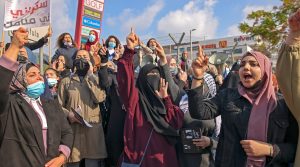PNN – According to the findings of the Cabinet Inspector General’s report, the average budget per student in the Zionist state-religious education sector is approximately 31 percent higher than the average budget for each student of Arab descent.
According to the report of Pakistan News Network, one of the internal issues in the occupied territories is the issue of systematic discrimination between the Arab community and the Zionist community. Arabs make up 21 percent of the population of approximately 10 million living in the occupied territories.
The backwardness of Arab cities compared to other regions was such that in 2021, a five-year plan for the development of the Arab sector was approved by Netanyahu’s cabinet, but to date, a large portion of the budgets included in this plan have not been allocated for various reasons.
Read more:
Zionists: We wanted to change the region, but we were rejected ourselves!
In this regard, an important part of the discrimination is related to the education system. A new report from the Taub Center, published in early April 2025, clearly paints a worrying picture of the state of education in the Arab sector. There are 6 types of education systems in Israel: state-secular, state-religious, yeshiva (affiliated with Haredi Jews), state-Arab (this group also includes Druze), private, and exceptional.
Meanwhile, the budget for public-Arab education in Israel is lower than for any other educational stream, while Jewish public-religious education receives the highest budget, even compared to secular public education. The gap between the highest and lowest budgets is 8 percent, reflecting institutionalized discrimination that has persisted for many years.
While the number of students in the Arab education system remained virtually unchanged between 2014 and 2023, the number of students in the public and religious Jewish education systems increased by 23%. More worryingly, when you look at the density of the different educational groups, you find that the Arab education system is actually not the most crowded.
According to data released by the Israeli Ministry of Education, only 20 percent of Arab students study in classes with more than 28 students, while 31 percent of religious-public schools and 50 percent of secular-public schools have more than 28 students.

This means that overcrowding is not the reason for the low budget of educational centers in the Arab sector. The reason for this is that budgeting is done based on sectoral dependencies, not needs; and this is the same systematic discrimination against Arabs compared to Zionists.
It is important to note that the Israeli Cabinet Inspectorate report from 2023 confirms this conclusion. According to the findings of the Cabinet Inspectorate report, the average budget per student in the Jewish state-religious education sector is approximately 31 percent higher than the average budget per student of Arab descent.
On the other hand, the educational attainment rate in Arab society is 65 percent. This number rises to 81.5 percent for Zionists. This statistic shows a deep gap that begins at the very early stages of education and deepens to university and the job market.
The Arab education system in the occupied territories therefore suffers from deep budget inequality, a lack of infrastructure, and a policy of permanent marginalization of Arabs. Even when funds are allocated to Arab areas in government decrees, these funds are paid to Arab schools late and sometimes stalled due to endless bureaucracy.
The impact of discrimination in education on the Arab labor market is direct and negative. A recently published report titled “Israel’s Outlook to 2048” found that if current discriminatory policies continue, unemployment rates and social gaps in the Arab community living in the occupied territories will deepen by 2048.

Despite these documents, the Finance Ministry of Netanyahu’s cabinet decided in the 2025 budget to increase financial support for yeshiva students while cutting $500 million from the budget for the implementation of the “Five-Year Arab Community Plan” under the pretext of a solution to cover military spending. Accordingly, the budget of the Ministry of Education and Training for the Arab sector will face a reduction of about $110,000, while the reduction in the transportation sector will be about $300,000. In addition, the housing construction sector, welfare services, and the provision of digital literacy will also be supported with fewer budgets.
Reducing this budget line will have a negative impact on the education process and the economic situation of the Arabs, because one of the major problems of the Arab sector is the lack of a proper transportation system to access job centers in Zionist cities. Thus, employment opportunities and integration into the economy will be reduced for Arab youth, and this could lead to a decrease in their motivation for education and training.
In this regard, a survey on Arab views on discrimination revealed that 85% of Arab citizens believe that there is a gap in equal opportunities. They see this in the unemployment rates between Arabs and Zionists, the rate of occupation of high-paying positions, and the salaries they receive. An Arab man earns almost half as much as a Zionist man per month. This discrimination is even worse for Arab working women. In this regard, a report by the Knesset Labor and Welfare Committee shows that more than 122,000 children from the Arab community, or about 47 percent of Arab children, are defined as “children at risk,” which also confirms the poor living conditions of Arab families.

